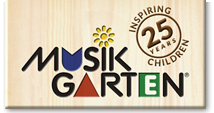Musikgarten is proud to partner with parents by delivering a highly informative series of publications, The Neuroscience of Music.* This installment is the last in a four-part set that touches on a Behavioral Wish List that matters to parents – Teaching children to move with rhythm and grace.
Rhythm may be the most important gift you can give your child, according to Dr. Dee Coulter, a renowned brain science educator. The reason is that the frontal lobe of the brain has its major growth spurt from birth to age six, when voluntary movement is developed. The developing brain must have rhythm to stimulate this important function and growth stage. This “sensory-motor integration” helps cultivate grace, or motor flow, by building the connections between rhythm and movement.
So, teaching children to move with rhythm and grace is very important to both early childhood music teachers and parents alike:
How parents Teach Their Babies Rhythm and Grace
The good news is, they’re most likely doing it already! Mothers instinctively instill rhythm in their babies, establishing a “comfort tempo” used often to help them calm.
- Simply nodding to a baby shows rhythmic approval and delight
- Gentle rocking, bouncing, or patting help to comfort babies with a familiar rhythm
- Humming, finger tapping, or even tongue-clicking are used by mothers get their babies attention
- Traditional nursery rhymes and songs have been used by generations of mothers to teach their children the love of music and rhythmic patterns.
How parents continue to teach rhythm and grace to their pre-school children through music:
As a baby’s frontal lobe continues to develop, there are many opportunities for parents, as well as early childhood music educators, to teach rhythm and grace with movement and music:
- Many infant and toddler games combine music with rhythmic movement. A few familiar traditional childhood songs that teach sensory motor integration are Patty Cakes, and Hop, Old Squirrel.
- Dancing with toddlers is a great way to teach them a multitude of developmental and social skills in addition to rhythm and grace, including self-esteem, discipline, and improved physical health.
- Families who have daily activities and routines such as making a bed in the morning, dinner together, teeth brushing before bed, and story time offers a slower rhythmic pattern which helps to reduce childhood stress and supports reading.
Parents don’t have to do this alone! There are many early childhood learning centers and programs that help parents teach their children from infancy to childhood how to use music to support healthy happy development in the earliest stages of life. Whether it is teaching children to relax and be calm, be patient, control their impulses, or move with rhythm and grace, The Neuroscience of Music supports the skills and techniques that cultures from around the world have been instilling in their children for generations.
*Musikgarten Delivers: The Neuroscience of Music collection by Dr. Dee Coulter is available for $10 in the Product Catalog section of our Teacher Portal. Username and password are required. You may also contact Musikgarten at 800-216-6864 to purchase.





